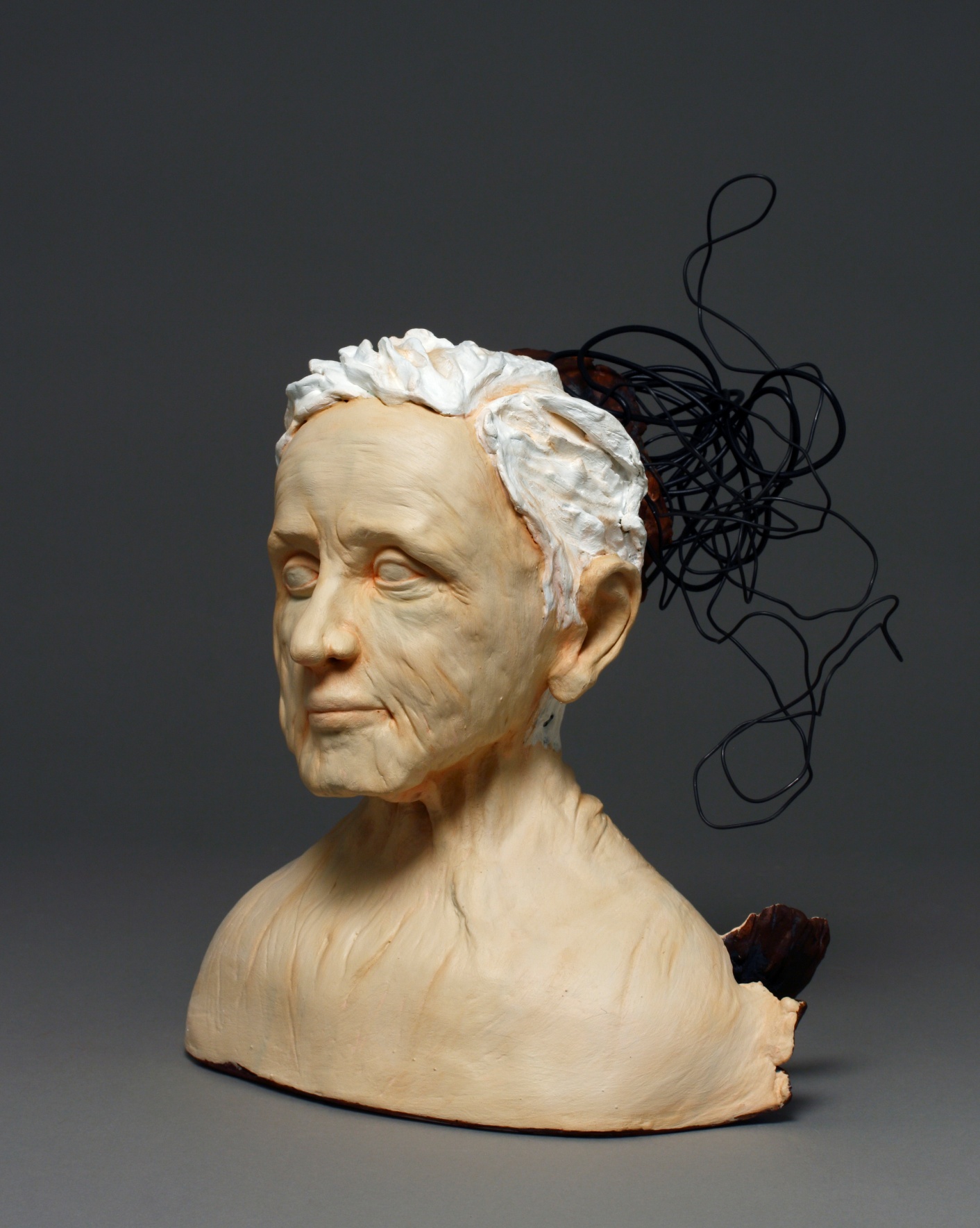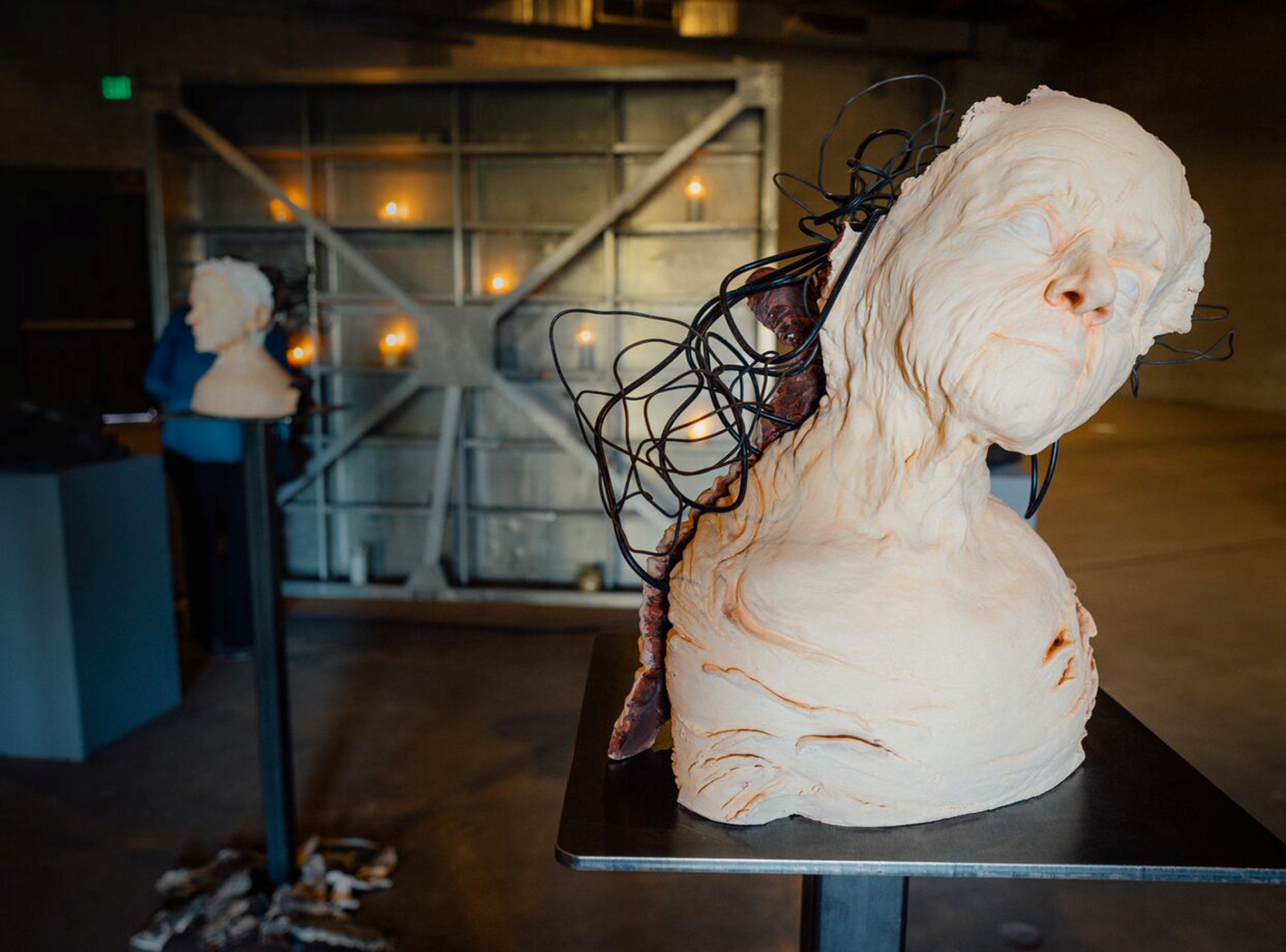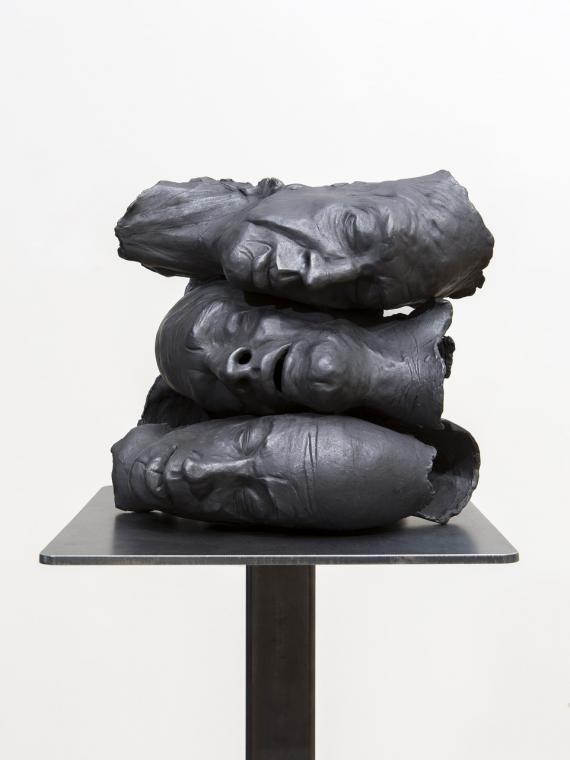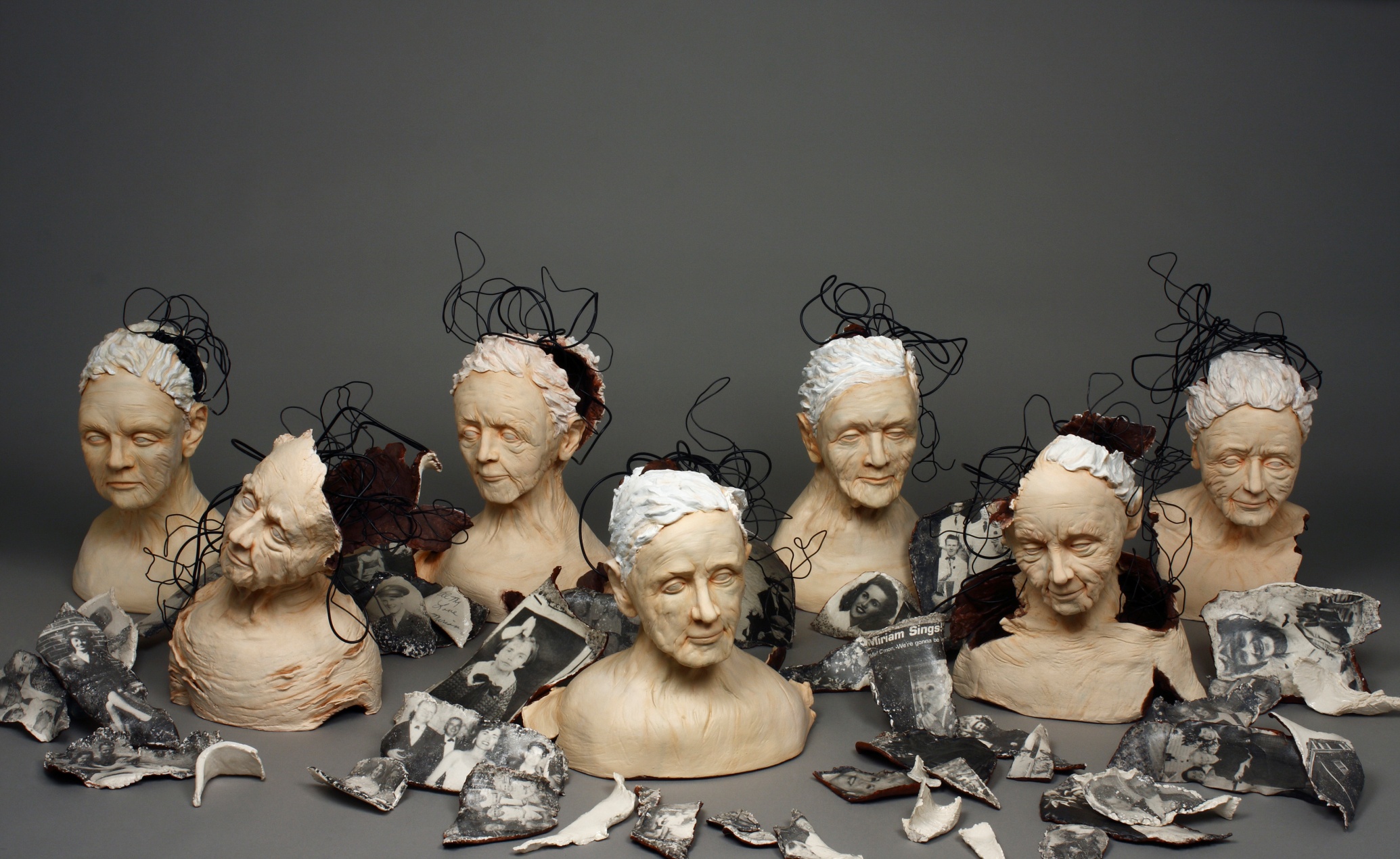Beauty in the Ephemeral – The Sculptures of Constance McBride
By David P. Kozinski
Working primarily in clay, many of Constance McBride’s sculptures reflect her interest in the issues of aging and mortality – subjects that have forever fascinated human beings, but especially artists and philosophers. She has recently created somewhat contorted forms rather than representational perfection, using dry surface treatments and her sculpting method. Sculptures such as “Whisperers” and “Strata Vita” are created with paperclay and graphite, the former being a mixture of clay, paper pulp and water. McBride notes, “Working with it is like working with any other clay body except that it is easily repairable at nearly every stage in the forming process.” She points out that works made with paperclay are of lighter weight than those done in conventional clay, which makes the medium ideal for wall installations and delicate forms. It also allows her to work on multiple pieces at a time because they remain malleable longer.
For the last few years she has worked on two series. After her mother received a diagnosis of Alzheimer’s disease, McBride began the Lonely Girls” series in 2011. She notes, “As time went on I realized I needed to do more than just one piece to try to capture what was happening to not only her [mother], but to many of the women she lived with in her assisted living facility. So the project grew. I've made seven of these.” Dignity and pathos combine in each of these works, but viewed together, as in the “studio shot” image, their impact increases exponentially. Seen from the front, some of the busts appear complete, while in others, the heads are fragmented – only partially depicted. The women’s faces are intact but in some instances there are wires and cords that emerge from the backs and sides of their heads in loops and tangles. Painted first with a commercial underglaze, the sculptures are treated with dry pastels and sprayed with a fixative post firing. Various stages and manifestations of Alzheimer’s are symbolized by the varying degrees of fragmentation of the heads.
McBride created another element to be displayed with the Lonely Girls. She poured through old family photographs, scanned them to a printer, and transferred them to decal paper which was then fired onto clay fragments. These shards of memory can appear in various ways, depending on the exhibition space. She has hung them from the ceiling and scattered them on the floor under the heads. Again the symbolism is powerful and not entirely without a surreal playfulness – a quality that only deepens the appreciation of this painful, baffling subject.
A native of Philadelphia, PA, who received a Bachelor of Arts from Arcadia University, McBride relocated from the east coast to the Southwest in 2002 and resides in Phoenix, Arizona. Her work is featured in the international platform and magazine Ceramics Now and the publication Paperclay Art and Practice by Rosette Gault. Most recently, her work was displayed in the inaugural Clay Houston Biennial in Texas and in the Clay Studio National, a group juried show at the Harrison and Reed + Smith Galleries in Philadelphia in the spring of 2016. McBride has also exhibited her work in Beyond The Brickyard, an international exhibition held each year at Archie Bray Foundation for Ceramic Arts in Montana.
The other series that has occupied McBride’s recent attention is “Whisperers” which is also the title of the first piece she created for it. Of this work, the artist writes, “…it’s about my mother and her passing, and about my own past lives haunting me as I age. Time had shifted…I felt, of course, very different and it came out in the work.” After firing the piece, she applied powdered graphite as a surface treatment, buffed it, and sealed it with a fixative. She had been planning to employ this technique for a long time and “Whisperers” presented the right opportunity. McBride was more than satisfied with the result and continued using graphite in works such as “Strata Vita” and “Metamorphosis Vita”, which for her, speak to the “passage of time and the layers of life we live.” These layers can be left behind; kept “crumpled on top, weighing us down”; or as reminders of our pasts.
The paperclay and graphite works appear somber and cool, flesh-like and vital, with their reflective graphite surfaces and contours both fluid and rough. The layers of “Metamorphosis Vita” look like four surfaces of female torsos, tiered one over another. If these surfaces remind the viewer of shed skins or hides, the three more rounded figures of “Strata Vita” suggest torsos; the bottom-most one is the flattest, weighed down by the two above, while the top figure is fuller and more complete looking.
Last December, McBride combined The Lonely Girls and Whisperers series with the memory shards for a solo exhibit in an old warehouse. To this installation, which was titled “Place out of Time”, she added audio of her mother singing and speaking. Phoenix New Times named this exhibition one of the 10 best art shows in the Phoenix Metro Area. In 2016, McBride received an Emerging Artist Grant from Contemporary Forum; a support organization for the Phoenix Art Museum.
McBride’s most recent work, “Fortis et Fidelis” (20” x 20” x 18”) combines elements from both of the series. She welded the “bird’s nest” at the top, which supports three real ostrich eggs, from metals found in a scrap yard. The nest’s materials, its shapes and placement echo the loops and tangles that emerge from some of the heads of the “Lonely Girls”. The piece’s base presents a seated human trunk, rendered in paperclay and graphite. The eggs were obtained from an ostrich farm near Phoenix. McBride colored them with milk paint and dusted them with pastels to achieve their dry finish and varied hues, which remind this viewer of some of the many naturally occurring pigmentations of human skin.
Women bearing the weight of the world is the sculpture’s subject. McBride adds, “We continue bearing children in what seems like a very bleak moment in time; with never-ending wars and increased violence against women and children. And it’s still about my mother, myself.”
McBride’s meditations on change and loss take three-dimensional form in her sculptures. The fragmented parts that comprise many of her works are, “a metaphor for lack of power and control, and are symbolic of the incomplete.” Despite the ravages that time and disease impose on the body, she perceives beauty in life’s ephemeral nature. “I am thinking about layers while investigating the changes our bodies experience over time; layers of relationships we develop and discard and layers of lore ancestors leave behind for us to ponder,” she writes. The artist’s tough-minded, warm-hearted approach to her subject matter results in art that neither shies away from nor revels in the painful. It can startle and soothe, provoke and reassure, the viewer. What matters to her is “that we are remembered as living beings and that death is thought of as a completion of a life well lived; not as a failure to survive on earth.”
David P. Kozinski won the Dogfish Head Poetry Prize, which included publication of his chapbook, Loopholes. He has been the featured poet in Schuylkill Valley Journal. Publications include Apiary, Fox Chase Review, glimmertrain.com, Philadelphia Stories, Poetry Repairs, Margie, and The Rathalla Review. Kozinski was one of ten poets chosen by Robert Bly for a workshop sponsored by American Poetry Review and has been nominated for the Pushcart Prize. He received Honorable Mention in Philadelphia Poets’ 7th Annual John & Rose Petracca & Family Award. Kozinski heads the publicity team for the Manayunk-Roxborough Art Center. He lives in Wilmington, DE with his wife, actress and journalist Patti Allis Mengers.





